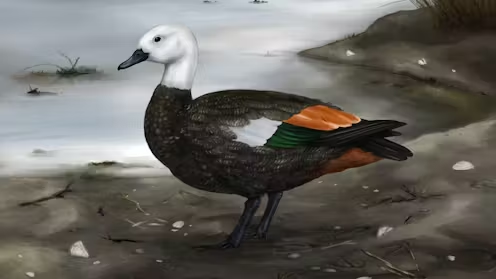A New Look at How Fast Birds Can Change
A team of scientists has confirmed the existence of an extinct shelduck that once lived on the far-off Chatham Islands. What makes this find stand out is the speed at which the bird evolved. In only 390,000 years, it became different enough from its mainland relatives to be classed as its own species. For the world of evolution, that is an extremely short time.
The bird has been named the Rēkohu shelduck, or Tadorna rekohu. The study, led by Nicolas Rawlence from the University of Otago, was published in the Zoological Journal of the Linnean Society in July 2025. The research used ancient DNA taken from fossil bones collected in the 1990s by Phil Millener from the Museum of New Zealand. The results showed that the extinct duck was most closely related to the paradise shelduck of New Zealand.
Island Life Speeds Up Evolution

The ancestors of this bird reached the Chatham Islands, 785 kilometers east of mainland New Zealand, during the Late Pleistocene period. Scientists believe they arrived during a warm phase that allowed them to travel long distances. Once there, the birds faced a very different environment. Food was plentiful, large predators were rare, and the winds were strong.
In such conditions, flying became less important for survival. Over time, the shelduck developed shorter and stronger wings along with longer legs. While it could still fly, it was not as skilled in the air as its mainland cousin. According to scientists, it seemed to be on the path to losing flight entirely before humans settled the islands.
Signs of a Bigger Pattern
This case matches a pattern researchers call “island syndrome,” where animals on islands change in predictable ways. For birds, this often means weaker flight muscles and stronger legs. A study in 2016 found that island birds tend to follow this path even if they do not become fully flightless. The Rēkohu shelduck was part of that trend.
Cultural and Historical Links

The naming of the species was done with the guidance of the Hokotehi Moriori Trust, the Indigenous group of the Chatham Islands. This step was important for reconnecting the research with local heritage. The Rēkohu shelduck went extinct not long after the Moriori people arrived around 1500 CE. Later, European and Māori arrivals changed the islands even more.
At the time humans first came to the Chathams, the islands were home to 64 breeding bird species, with more than half found nowhere else. Today, only the grey duck remains from the group of nine waterfowl species once present.
My View
This discovery is more than a story about a bird. It is a reminder of how quickly nature can adapt when the conditions are right, and how just as quickly species can vanish when those conditions change. Island ecosystems are often fragile, and the Rēkohu shelduck’s fate shows the risk they face from human arrival. For me, the most striking part is that the bird’s entire existence as a separate species was shorter than human recorded history, yet it still left behind clues that could be studied hundreds of years later.
Sources: phys.org

